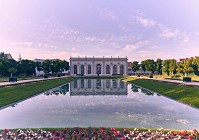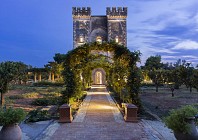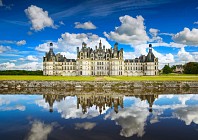Coco Chanel once quipped: “Luxury must be comfortable, otherwise it is not luxury.” While snow-capped mountains are seldom equated with comfort, luxury, or indeed Coco Chanel, all three spring to mind as I stomp through Courchevel, weighed down by ski boots, poles, and my skis balanced over one shoulder.
Formerly referred to as Courchevel 1850, Courchevel is one of four villages that constitute the Courchevel Resort in Les Trois Vallées (The Three Valleys) region of the French Alps. Courchevel Moriond (formerly 1650), Courchevel Village (1550), and Courchevel Le Praz (1300) lie further down the mountain.
The Courchevel authorities changed the names of each village for the 2012–2013 ski season, in an attempt to give each village its own personality. Hitherto, it was feared that skiers were naturally drawn to 1850 because of its superior altitude.
But it would seem that dropping the four-digit suffix has only served to enhance Courchevel’s exclusive status. The other three villages are picture-perfect, self-contained ski resorts, each offering a generous array of luxury hotels and chalets, yet the village formerly known as 1850 remains unparalleled for its unabashed ostentatiousness, and continues to uphold its reputation as a playground for European royalty, oligarchs and their entourages, and the sheikhs of resource-rich Gulf states.
It’s also a place where fashion and art seem to collide. For every Chanel, Louis Vuitton, Hermès or Prada boutique, there’s a gallery or high-profile exhibition. In 2010, the village became an open-air Salvador Dalí museum, while in 2012 French sculptor Orlinski famously planted his sculpture The White Wolf atop the 2,659-metre summit of the Vizelle and dotted a selection of other eye-catching creations around the village.

Today, Courchevel’s snowy streets are punctuated with works from Brazilian pop artist Romero Britto and French contemporary artist Richard Orlinski. Britto’s works in particular, such as Bow Tie Cat and Winter Bear, offer collages of colour that pleasantly contrast with the winter wonderland landscape.
Last year, Courchevel paid tribute to Chanel in line with Paris Fashion Week. A pop-up Chanel store rivalled the expensive sophistication of surrounding permanent boutiques, while a selection of Karl Lagerfeld sketches adorned 36 of the 72 Jardin Alpin cable cars. I don’t feel as though I’m missing out on last year’s festivities; walking through Courchevel is tantamount to strutting down a Parisian catwalk.
If my journey from slope to bar is a cultural tour, then my arrival at Le Ku De Ta is a glimpse into another world. The popular après-ski destination overflows with furs and Swarovski-encrusted skiwear, and I find myself one of the few people in bar actually wearing ski boots. It would appear that being a part of the ‘ski scene’ here doesn’t necessarily involve actually hitting the slopes.
While Courchevel’s après-ski isn’t as diverse as that of other resorts in Les Trois Vallées (or indeed the other Courchevel villages), it is famous — infamous, even —for its flamboyance. The nearby La Grange nightclub is renowned for slapping a charge of US $16,335 for top tables on New Year’s Eve and Orthodox Christmas, and a jeroboam of Cristal will cost discerning patrons a cool $6,262.
With this kind of money flying around, it’s little wonder some of France’s greatest chefs have been enticed to Courchevel. Now, the small village of just under 2,000 inhabitants has the world’s most Michelin stars per capita.

Le Chabichou, Yannick Alléno’s Le 1947, Pierre Gagnaire pour Les Airelles, Le Strato, La Table du Kilimandjaro, and Le Kintessence in Hôtel Le K2, each boast two stars — 12 in total, one for every 164 villagers. There are even two new Michelin stars twinkling further down the slopes at Azimut Restaurant in Courchevel Le Praz and Le Farçon at Courchevel
La Tania.
In keeping with the starry theme, a number of these restaurants are housed in Courchevel’s most famous six-star ‘palaces’. Earlier in the day, my ski instructor pointed out what appeared to be a large, over-iced wedding cake nestled beside the slopes.
This, he told me, was Les Airelles, a palatial hotel with 34 rooms, 14 suites, a private apartment and separate chalet, as well as a spa (featuring sauna, hammam, swimming pool, indoor and outdoor whirlpool and a snow cave, no less), a private library for the more bookish of guests, and Gagnaire’s aforementioned Michelin-starred restaurant.
I asked my instructor how much a room there would cost for the night. He muttered a figure. I must have misheard him. Surely nowhere, however many stars, could have the audacity to slap that many zeroes onto the end of a bill. I raised my eyebrows in disbelief. With a smile, he shrugged his shoulders as if to say: “Fine, don’t believe me.”
Back at Le Ku De Ta, the resident DJ has just taken to the decks to spin the kind of chill-out soundtrack synonymous with beachside/slope-side chic. I hear the familiar pop of a champagne cork, but the usual choral accompaniment of cheers is absent. It’s no big deal. This is the order of things in Courchevel: champagne, shopping, contemporary art, and maybe even a spot of skiing. Maybe.

The swimming pool at Hôtel Le K2
THE GOLDEN BOOK
Cheval Blanc Courchevel
Tel: +33 4 79 00 50 50
courchevel.chevalblanc.com
L’Apogée COURCHEVEL
Tel: +33 4 79 04 01 04
lapogeecourchevel.com
Les Airelles
Tel: +33 4 79 00 38 38
airelles.fr
HITTING THE SLOPES
The Courchevel resort offers 150 kilometres of ski runs: 19 green runs, 37 blue, and 31 red and eight black runs for more experienced skiers. Many of the slopes are north facing, meaning there’s still great snow late in the season. The slopes are served by 58 lifts, 365 days a year, which open at 9am and begin to close from about 4.20pm (times vary and lifts often close later in February). The ski season for Courchevel, Courchevel Village, and Courchevel Le Praz runs until April 6-24, while Courchevel Moriond starts December 13.












